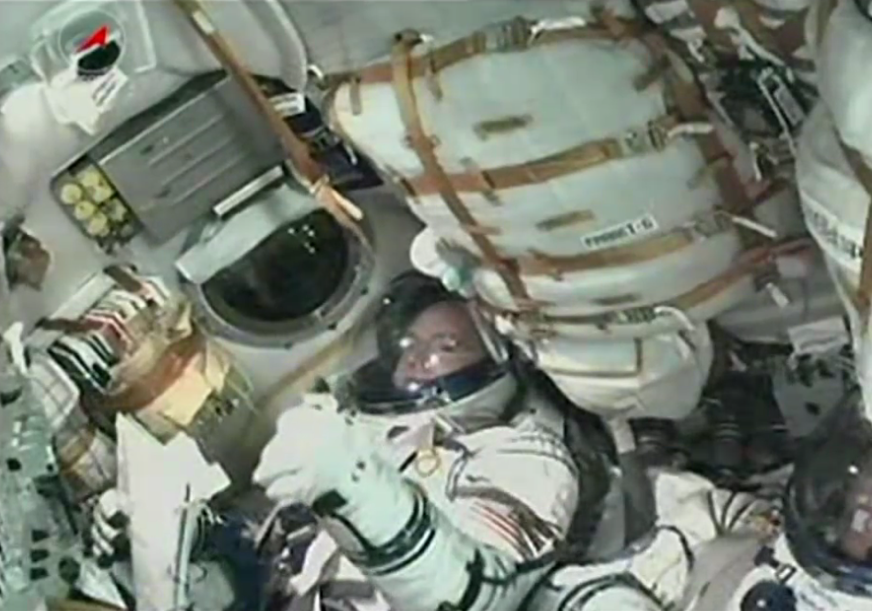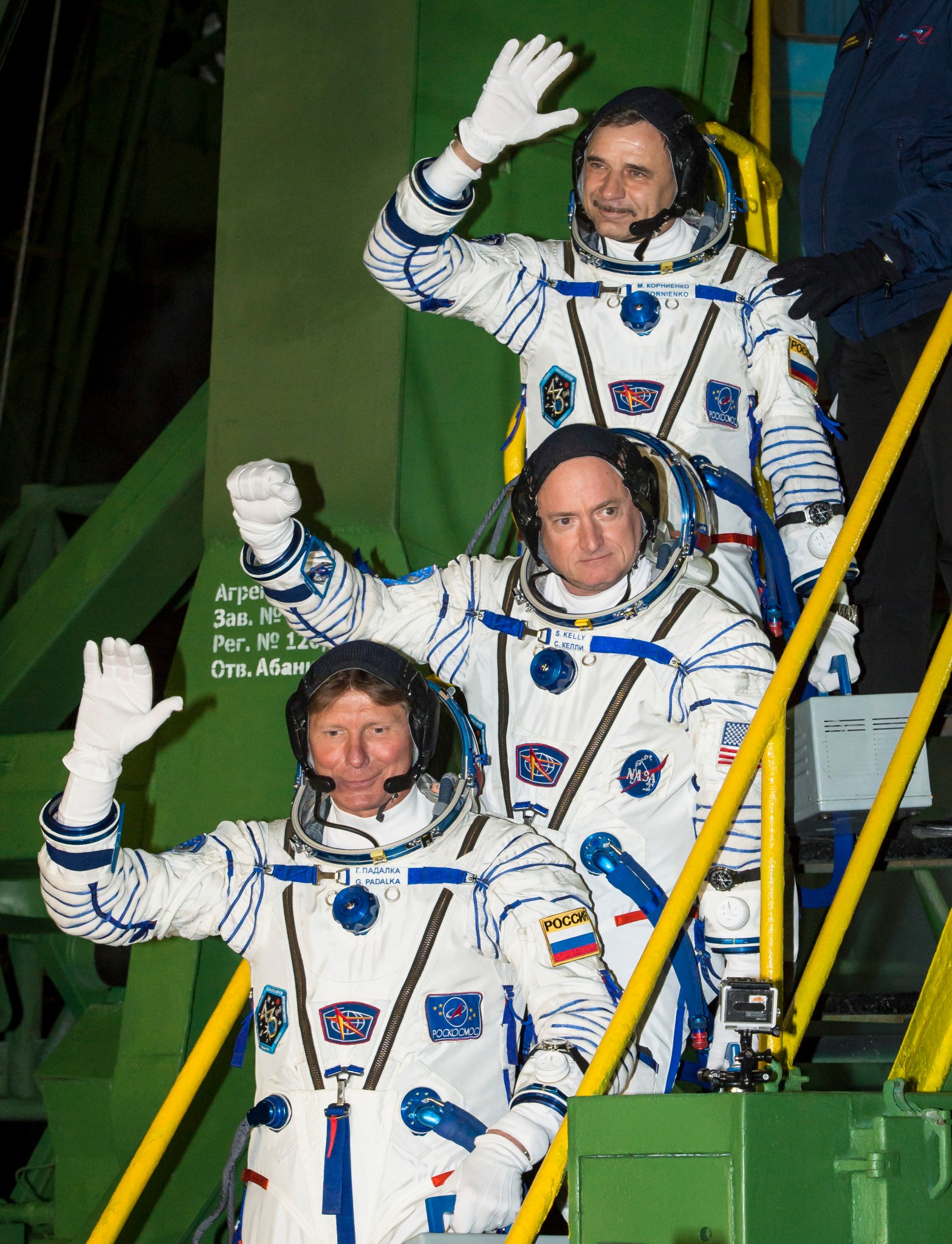
Three crew members representing the United States and Russia are on their way to the International Space Station after launching from the Baikonur Cosmodrome in Kazakhstan at 3:42 p.m. EDT Friday (1:42 a.m., March 28 in Baikonur).
NASA astronaut Scott Kelly and Russian Federal Space Agency (Roscosmos) cosmonaut Mikhail Kornienko will spend about a year living and working aboard the space station to help scientists better understand how the human body reacts and adapts to the harsh environment of space.
“Scott Kelly’s mission is critical to advancing the administration’s plan to send humans on a journey to Mars,” said NASA Administrator Charles Bolden. “We’ll gain new, detailed insights on the ways long-duration spaceflight affects the human body.”
Launching with Kelly and Kornienko was cosmonaut Gennady Padalka, who will spend a standard six-month rotation on the station. The trio is scheduled to dock with the station at 9:36 p.m., about six hours after launch. NASA Television coverage of docking will begin at 8:45 p.m. Hatches are scheduled to open at about 11:15 p.m., with coverage starting at 10:45 p.m.

The arrival of Kelly, Kornienko and Padalka returns the station’s crew complement to six. The three will join Expedition 43 commander Terry Virts of NASA, as well as flight engineers Samantha Cristoforetti of ESA (European Space Agency) and Anton Shkaplerov of Roscosmos, who have been aboard the complex since November.
Virts, Cristoforetti and Shkaplerov will return home in May. At that time, Padalka will take command of Expedition 44, becoming the first person to command four station crews. Padalka will return in September, while Kelly and Kornienko will remain aboard until March 2016.
The one-year mission will focus on seven key areas of human research. Functional studies will examine crew member performance during and after the 12-month expedition. Behavioral studies will monitor sleep patterns and exercise routines. Visual impairment will be studied by measuring changes in pressure inside the human skull. Metabolic investigations will examine the immune system and effects of stress.
Physical performance will be monitored through exercise examinations. Microbial changes in the crew will be monitored, as well as the human factors associated with how the crew interacts aboard the station. Each of these key elements carries a potential benefit for populations here on Earth, from functional improvements for patients recovering from a long period of bed rest to improving the monitoring of immune functions of people on Earth with altered immunity.
Data from Kelly and Kornienko’s 342-day expedition will be used to determine whether there are ways to further reduce the risks on future long-duration missions necessary for deep space missions.
In tandem with the one-year mission, Kelly’s identical twin brother, former NASA astronaut Mark Kelly, will participate in a number of comparative genetic studies, including the collection of blood samples as well as psychological and physical tests. This research will compare data from the genetically identical Kelly brothers to identify any subtle changes caused by spaceflight.
The tests will track any degeneration or evolution that occurs in the human body from extended exposure to a microgravity environment. These new twin studies are a multi-faceted national cooperation between universities, corporations and government laboratory expertise.
Expedition 43 will perform scientific research in several other fields, such as astrophysics and biotechnology. Among the planned experiments are a study of meteors entering Earth’s atmosphere and testing of a new synthetic material that can expand and contract like human muscle tissue. The crew members also are scheduled to greet a host of cargo spacecraft during their mission, including the sixth SpaceX commercial resupply flight and a Russian Progress resupply mission. Each flight will carry several tons of food, fuel, supplies and research. No spacewalks are planned during Expedition 43.
The International Space Station is a convergence of science, technology and human innovation that demonstrates new technologies and makes research breakthroughs that are not possible on Earth. The space station has been continuously occupied since November 2000. In this time, it has received more than 200 visitors and a variety of international and commercial spacecraft. The space station remains the springboard to NASA’s next giant leap in exploration.
For NASA TV streaming video, downlink and scheduling information, visit:
https://www.nasa.gov/nasatv
For more information about this mission to the space station, visit:
http://go.nasa.gov/1ee6ju6
For more information about the research on this mission, visit:
http://go.nasa.gov/1HPhPpz
To follow activities on orbit, visit the space station Facebook page at:
http://www.facebook.com/ISS
Follow the crew members and the station on Twitter at:
http://www.twitter.com/nasa_astronauts
and
http://www.twitter.com/Space_Station
Follow Kelly and the station on Instagram at:
and
-end-
Due to increased fire activity from the Happy Camp Complex, the Siskiyou County Sheriff’s Office is issuing a mandatory evacuation order effective 6:00 p.m. PDT on Tuesday, September 2, 2014.
The National Weather Service issued a fire weather watch through September 3, Wednesday evening because of a combination of strong winds and extremely dry conditions. North to northeast winds of 10 to 20 mph are expected, which will increase fire behavior and possibly create plume-dominated fire, when the power of the fire exceeds the power of surface winds. Extreme fire behavior with long-range spotting could occur.
The wildfire began on Tuesday August 12, 2014 at approximately 1 a.m. PDT from a lightning strike, according to the Incident Information System. InciWeb is an interagency all-risk incident information management system that includes various federal and state agencies that provide up-to-date information on wildfires.
This natural-color satellite image was collected by the Moderate Resolution Imaging Spectroradiometer (MODIS) aboard the Terra satellite on September 2, 2014. Actively burning areas, detected by MODIS’s thermal bands, are outlined in red.
NASA image courtesy Jeff Schmaltz, MODIS Rapid Response Team. Caption by Rob Gutro, NASA Goddard, with information from Inciweb.
Stephanie Schierholz
Headquarters, Washington
202-358-1100
stephanie.schierholz@nasa.gov
Dan Huot
Johnson Space Center, Houston
281-483-5111
daniel.g.huot@nasa.gov























